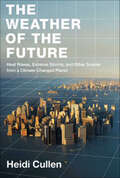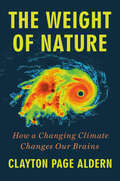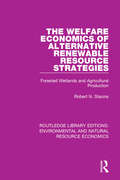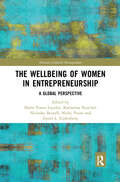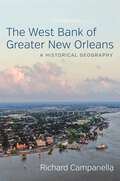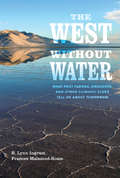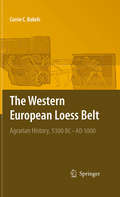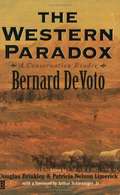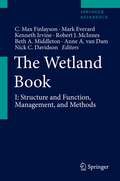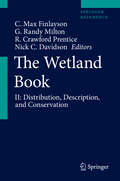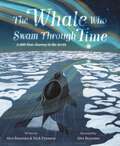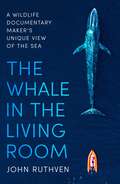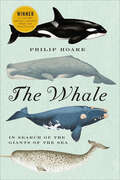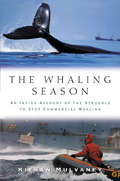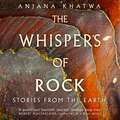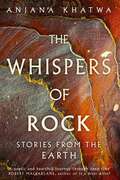- Table View
- List View
The Weather Today: Independent Reading Non-Fiction Pink 1a (Reading Champion #515)
by Jackie WalterThis book is part of Reading Champion, a series carefully linked to book bands to encourage independent reading skills, developed with UCL Institute of Education (IOE)The Weather Today is a non-fiction text exploring how different clothes are suitable for different weather. The repeated sentence structure offers readers the opportunity for a very first independent reading experience with the support of the illustrations.Reading Champion offers independent reading books for children to practise and reinforce their developing reading skills.This early non-fiction text is accompanied by engaging artwork and a reading activity. Each book has been carefully graded so that it can be matched to a child's reading ability, encouraging reading for pleasure.
The Weather and Climate: Emergent Laws and Multifractal Cascades
by Shaun Lovejoy Daniel SchertzerAdvances in nonlinear dynamics, especially modern multifractal cascade models, allow us to investigate the weather and climate at unprecedented levels of accuracy. Using new stochastic modelling and data analysis techniques, this book provides an overview of the nonclassical, multifractal statistics. By generalizing the classical turbulence laws, emergent higher-level laws of atmospheric dynamics are obtained and are empirically validated over time-scales of seconds to decades and length-scales of millimetres to the size of the planet. In generalizing the notion of scale, atmospheric complexity is reduced to a manageable scale-invariant hierarchy of processes, thus providing a new perspective for modelling and understanding the atmosphere. This synthesis of state-of-the-art data and nonlinear dynamics is systematically compared with other analyses and global circulation model outputs. This is an important resource for atmospheric science researchers new to multifractal theory and is also valuable for graduate students in atmospheric dynamics and physics, meteorology, oceanography and climatology.
The Weather of the Future: Heat Waves, Extreme Storms, and Other Scenes from a Climate-Changed Planet
by Heidi Cullen“A scorching vision of what life might be like in the warmer world that is already on its way. " — Michiko Kakutani, New York Times“Vivid and compelling, this book shows what life will be like in a warming world. Essential reading for anyone who’s planning to inhabit the planet for the next few decades.” — Elizabeth Kolbert, author of Field Notes from a CatastropheFrom Heidi Cullen, one of America’s foremost experts on weather and climate change and a senior research scientist with Climate Central, a fascinating and provocative book that predicts what different parts of the world will look like in the year 2050 if current levels of carbon emissions are maintained.Dr. Heidi Cullen, one of the world’s foremost climatologists and environmental journalists, offers a new way of viewing the climate-change phenomenon, not as some future event but as something happening right now in our own backyard. In this groundbreaking, provocative work, Dr. Cullen combines the latest scientific research with state-of-the-art climate-model projections to create climate-change scenarios for seven of the most at-risk locations around the globe.From the Central Valley of California, where coming droughts will jeopardize the entire state’s water supply, to New York City, whose infrastructure is extremely vulnerable to even a relatively weak Category 3 hurricane, to Greenland, where warmer temperatures will give access to mineral wealth buried beneath ice sheets for millennia, Cullen illustrates how, if left unabated, climate change will transform every corner of the world by midcentury—and no two regions will be affected in quite the same way.
The Weierstrass Elliptic Function and Applications in Classical and Quantum Mechanics: A Primer for Advanced Undergraduates (SpringerBriefs in Physics)
by Georgios PastrasThe field of elliptic functions, apart from its own mathematical beauty, has many applications in physics in a variety of topics, such as string theory or integrable systems. This book, which focuses on the Weierstrass theory of elliptic functions, aims at senior undergraduate and junior graduate students in physics or applied mathematics. Supplemented by problems and solutions, it provides a fast, but thorough introduction to the mathematical theory and presents some important applications in classical and quantum mechanics. Elementary applications, such as the simple pendulum, help the readers develop physical intuition on the behavior of the Weierstrass elliptic and related functions, whereas more Interesting and advanced examples, like the n=1 Lamé problem-a periodic potential with an exactly solvable band structure, are also presented.
The Weierstrass Sigma Function in Higher Genus and Applications to Integrable Equations (Springer Monographs in Mathematics)
by Shigeki MatsutaniThis book’s area is special functions of one or several complex variables. Special functions have been applied to dynamics and physics. Special functions such as elliptic or automorphic functions have an algebro-geometric nature. These attributes permeate the book. The “Kleinian sigma function”, or “higher-genus Weierstrass sigma function” generalizes the elliptic sigma function. It appears for the first time in the work of Weierstrass. Klein gave an explicit definition for hyperelliptic or genus-three curves, as a modular invariant analogue of the Riemann theta function on the Jacobian (the two functions are equivalent). H.F. Baker later used generalized Legendre relations for meromorphic differentials, and brought out the two principles of the theory: on the one hand, sigma uniformizes the Jacobian so that its (logarithmic) derivatives in one direction generate the field of meromorphic functions on the Jacobian, therefore algebraic relations among them generate the ideal of the Jacobian as a projective variety; on the other hand, a set of nonlinear PDEs (which turns out to include the “integrable hierarchies” of KdV type), characterize sigma. We follow Baker’s approach. There is no book where the theory of the sigma function is taken from its origins up to the latest most general results achieved, which cover large classes of curves. The authors propose to produce such a book, and cover applications to integrable PDEs, and the inclusion of related al functions, which have not yet received comparable attention but have applications to defining specific subvarieties of the degenerating family of curves. One reason for the attention given to sigma is its relationship to Sato's tau function and the heat equations for deformation from monomial curves. The book is based on classical literature and contemporary research, in particular our contribution which covers a class of curves whose sigma had not been found explicitly before.
The Weight of Nature: How a Changing Climate Changes Our Brains
by Clayton Page AldernA New York Times Editors' ChoiceA Next Big Idea Club and Sierra Magazine Must-Read BookA Behavioral Scientist&’s Notable Book of 2024A Financial Times Best Summer BookA Bookshop Most Notable Science Book of 2024A deeply reported, eye-opening book about climate change, our brains, and the weight of nature on us all.The march of climate change is stunning and vicious, with rising seas, extreme weather, and oppressive heat blanketing the globe. But its effects on our very brains constitute a public-health crisis that has gone largely unreported. Based on seven years of research, this book by the award-winning journalist and trained neuroscientist Clayton Page Aldern, synthesizes the emerging neuroscience, psychology, and behavioral economics of global warming and brain health. A masterpiece of literary journalism, this book shows readers how a changing environment is changing us today, from the inside out.Aldern calls it the weight of nature.Hotter temperatures make it harder to think clearly and problem-solve. They increase the chance of impulsive violence. Immigration judges are more likely to reject asylum applications on hotter days. Umpires, to miss calls. Air pollution, heatwaves, and hurricanes can warp and wear on memory, language, and sensory systems; wildfires seed PTSD. And climate-fueled ecosystem changes extend the reach of brain-disease carriers like mosquitos, brain-eating amoebas, and the bats that brought us the mental fog of long COVID.How we feel about climate change matters deeply; but this is a book about much more than climate anxiety. As Aldern richly details, it is about the profound, direct action of global warming on our brains and behavior—and the most startling portrait yet of unforeseen environmental influences on our minds. From farms in the San Joaquin Valley and public schools across the United States to communities in Norway&’s Arctic, the Micronesian islands, and the French Alps, this book is an unprecedented portrait of a global crisis we thought we understood.
The Welfare Economics of Alternative Renewable Resource Strategies: Forested Wetlands and Agricultural Production (Routledge Library Editions: Environmental and Natural Resource Economics)
by Robert N. StavinsThis study, originally published in 1990, seeks to address several important policy questions associated with the ongoing depletion of forested wetlands. First, in the context of Environmental Impact Statements, should the estimated areas of impact of Federal flood-control and drainage projects on wetlands be limited to (minimal) construction impacts, or should they include impacts which occur when such projects cause private landowners to drain and clear their wetland holdings? A second crucial question is whether wetland depletion and conversion to agricultural cropland has been excessive. This title will be of interest to students of Environmental Economics and Policy.
The Well-Chosen Garden
by Christopher LloydThe perfect book on how to make your garden the best it can be.'Essential reading' Country Life'Funny, encouraging, informative' Sunday TimesWould your garden, small or large, in town or country, win a prize? Is there room for improvement? Everybody has favourite plants, but the ability to put them all together to ensure a splendid show throughout the year is a skill that must be acquired. THE WELL-CHOSEN GARDEN will guide you to making the most of your available space, help you avoid untimely gaps, colour clashes and many other pitfalls of garden planning.The perfect book for new and experienced gardeners alike.
The Well-Chosen Garden
by Christopher LloydThe perfect book on how to make your garden the best it can be.'Essential reading' Country Life'Funny, encouraging, informative' Sunday TimesWould your garden, small or large, in town or country, win a prize? Is there room for improvement? Everybody has favourite plants, but the ability to put them all together to ensure a splendid show throughout the year is a skill that must be acquired. THE WELL-CHOSEN GARDEN will guide you to making the most of your available space, help you avoid untimely gaps, colour clashes and many other pitfalls of garden planning.The perfect book for new and experienced gardeners alike.
The Well-Tempered Garden: A New Edition Of The Gardening Classic
by Christopher LloydA timeless gardening classic by Christopher Lloyd, one of Britain's most highly respected plantsmen, updated for the 21st century. With a new foreword by Anna Pavord.This is a classic work by a gardener who combines a passionate love of his subject with a critical intelligence and a good helping of wit. THE WELL-TEMPERED GARDEN is packed with the sort of information keen gardeners crave - from planting, weeding and the pleasures of propagation to annuals, water lilies and vegetables. Hailed as a masterpiece when it was first published, THE WELL-TEMPERED GARDEN is as fresh, enlightening and necessary for gardeners in the 21st century as it was when it first appeared more than 40 years ago.
The Wellbeing Purpose: How Companies Can Make Life Better
by Richard HardymentIn a turbulent world of geopolitical change, declining trust in institutions, and increasing scrutiny of companies, the big question facing leaders is: what difference does business make? Lots of companies talk about social impact, but few have defined what it really means. This book sets out a more human form of capitalism with people at its heart. The Wellbeing Purpose is the first book that explains how companies can make life better across their value chains, from sourcing raw materials to innovating, marketing and selling products and services. This book is a blueprint for raising life satisfaction for all those touched by a business – suppliers, employees, communities and consumers. It sets out the steps for any organization to create profits (wealth creation) whilst simultaneously making life better (wellbeing enhancement). Drawing on his experience as a political adviser and business consultant, Hardyment takes us on a journey across the global footprint of business. There are some startling findings along the way. Case studies from pioneering firms and the latest scientific research are used to explain how any organization can source, make and market products that create wealth and wellbeing. This is a manifesto for business to profit through helping more people to realize the good life.
The Wellbeing of Women in Entrepreneurship: A Global Perspective (Human Centered Management)
by Nicholas J. Beutell María Teresa Lepeley Katherina Kuschel Nicky R. M. Pouw Emiel L. EijdenbergWomen accomplish nearly two-thirds of total work around the world (including household duties), comprise one-third of the formal labor force, but women receive one-tenth of the world's income and own only one-hundredth of the world’s property. Entrepreneurship is a vehicle for advancing the lives of women around the world. This book brings together 49 distinguished entrepreneurship scholars to provide a unique global vision of the wellbeing of women entrepreneurs necessary for fostering sustainable development and inclusive societies. Although gender inequality is an important issue, solutions leading to gender parity are far from reaching ideal levels in the formal workplace and globally. Meanwhile the number of women involved in entrepreneurship is growing exponentially because there are more opportunities for women to own a business and be their own boss. This offers women the most desirable and flexible working conditions that better align with women’s lifestyles and multiple family responsibilities. However, entrepreneurial activities are demanding and complex; compared to men, women face special challenges that deserve close attention. This book presents research and programs to effectively support women entrepreneurs in reaching levels of wellbeing required to ensure business sustainability and personal prosperity. Offering a diversity perspectives from around the globe, The Wellbeing of Women in Entrepreneurship is of great interest to academics and practitioners working in teaching and research in disciplines including business management, entrepreneurship, oganizational change, human centered management, human resources, sustainable development, and women’s studies.
The West Bank of Greater New Orleans: A Historical Geography
by Richard CampanellaThe West Bank has been a vital part of greater New Orleans since the city’s inception, serving as its breadbasket, foundry, shipbuilder, railroad terminal, train manufacturer, and even livestock hub. At one time it was the Gulf South’s St. Louis, boasting a diversified industrial sector as well as a riverine, mercantilist, and agricultural economy. Today the mostly suburban West Bank is proud but not pretentious, pleasant if not prominent, and a distinct, affordable alternative to the more famous neighborhoods of the East Bank. Richard Campanella is the first to examine the West Bank holistically, as a legitimate subregion with its own story to tell. No other part of greater New Orleans has more diverse yet deeply rooted populations: folks who speak in local accents, who exhibit longstanding cultural traits, and, in some cases, who maintain family ownership of lands held since antebellum times—even as immigrants settle here in growing numbers. Campanella demonstrates that West Bankers have had great agency in their own place-making, and he challenges the notion that their story is subsidiary to a more important narrative across the river. The West Bank of Greater New Orleans is not a traditional history, nor a cultural history, but rather a historical geography, a spatial explanation of how the West Bank’s landscape formed: its terrain, environment, land use, jurisdictions, waterways, industries, infrastructure, neighborhoods, and settlement patterns, past and present. The book explores the drivers, conditions, and power structures behind those landscape transformations, using custom maps, aerial images, photographic montages, and a detailed historical timeline to help tell that complex geographical story. As Campanella shows, there is no “greater New Orleans” without its cross-river component. The West Bank is an essential part of this remarkable metropolis.
The West without Water
by Frances Malamud-Roam B. Lynn IngramThe West without Water documents the tumultuous climate of the American West over twenty millennia, with tales of past droughts and deluges and predictions about the impacts of future climate change on water resources. Looking at the region's current water crisis from the perspective of its climate history, the authors ask the central question of what is "normal" climate for the West, and whether the relatively benign climate of the past century will continue into the future. The West without Water merges climate and paleoclimate research from a wide variety of sources as it introduces readers to key discoveries in cracking the secrets of the region's climatic past. It demonstrates that extended droughts and catastrophic floods have plagued the West with regularity over the past two millennia and recounts the most disastrous flood in the history of California and the West, which occurred in 1861-62. The authors show that, while the West may have temporarily buffered itself from such harsh climatic swings by creating artificial environments and human landscapes, our modern civilization may be ill-prepared for the future climate changes that are predicted to beset the region. They warn that it is time to face the realities of the past and prepare for a future in which fresh water may be less reliable.
The Western European Loess Belt
by Corrie C. BakelsThis book deals with the early history of agriculture in a defined part of Western Europe: the loess belt west of the river Rhine. It is a well-illustrated book that integrates existing and new information, starting with the first farmers and ending when food production was no longer the chief source of livelihood for the entire population. The loess belt was chosen because it is a region with only one type of soil and climate as these are all-important factors where farming is concerned. Subjects covered are crops, crop cultivation, livestock and livestock handling, the farm and its yard, and the farm in connection with other farms. Crop plants and animals are described, together with their origin. New tools such as the plough, wheen, wagon and scythe are introduced. Groundplans of farm buildings, the history of the outhouse and the presence or absence of hamlets are presented as well, and the impact of farming on the landscape is not forgotten. The loess belt was not an island and the world beyond its boundaries was important for new ideas, new materials and new people. Summarising six millennia of agriculture, the thinking in terms of the Western European loess belt as one agricultural-cultural unit seems justified.
The Western Paradox: A Conservation Reader
by Arthur M. Schlesinger Bernard Devoto Douglas Brinkley Patricia NelsonThis book is the fascinating record of DeVoto's crusade to save the West from itself.
The Wetland Book: Distribution, Description, And Conservation
by Mark Everard Beth A. Middleton C. Max Finlayson Nick C. Davidson Kenneth Irvine Robert J. McInnes Anne A. van DamThe Wetland Book is a comprehensive resource aimed at supporting the trans- and multidisciplinary research and practice which is inherent to this field. Aware both that wetlands research is on the rise and that researchers and students are often working or learning across several disciplines, The Wetland Book is a readily accessible online and print reference which will be the first port of call on key concepts in wetlands science and management. This easy-to-follow reference will allow multidisciplinary teams and transdisciplinary individuals to look up terms, access further details, read overviews on key issues and navigate to key articles selected by experts
The Wetland Book: Distribution, Description, And Conservation
by C. Max Finlayson G. Randy Milton R. Crawford Prentice Nick C. DavidsonThe Wetland Book is a comprehensive resource aimed at supporting the trans- and multidisciplinary research and practice which is inherent to this field. Aware both that wetlands research is on the rise and that researchers and students are often working or learning across several disciplines, The Wetland Book is a readily accessible online and print reference which will be the first port of call on key concepts in wetlands science and management. This easy-to-follow reference will allow multidisciplinary teams and transdisciplinary individuals to look up terms, access further details, read overviews on key issues and navigate to key articles selected by experts.
The Whale Who Swam Through Time: A Two-Hundred-Year Journey in the Arctic
by Nick Pyenson Alex BoersmaThis sweeping nonfiction picture book The Whale Who Swam Through Time explores the 200-year lifespan of a bowhead whale and the changing environment that surrounds her.Almost 200 years ago . . .Our journey begins with the birth of a bowhead whale, the longest-living mammal in the world. Over the course of her life in the Arctic, the bowhead whale witnesses many changes: from an era of peace and solitude to one of oil rigs and cruise liners.With gorgeous, detailed, and striking illustrations, this well researched and thoughtfully curated nonfiction story captures the magic and beauty of the natural world, while also providing a thoughtful account of how humans have impacted our changing ecosystems and a call-to-action for protecting the environment.
The Whale in the Living Room
by John RuthvenThe Whale in the Living Room follows the thrilling adventures of award-winning wildlife documentary producer, John Ruthven, on a journey of discovery - by turns memorable, touching and often funny -that has helped the undersea world flow into countless living rooms to reveal many of our ocean's mysteries.John is the only producer to have worked on both Blue Planet and Blue Planet II, presented by David Attenborough, in total making nearly fifty ocean films, including episodes of Discovery Shark Week, expedition films for National Geographic and coral conservation documentaries for PBS. With innovative technology he has helped capture unique images of a sperm whale mother and calf, pictures of glowing creatures half a mile deep, and grey reef sharks hunting by the light of the moon. We swim with him through blue lagoons, dive into the abyss to encounter new life forms, and experience everything from the danger of getting lost at sea to the sadness of finding a starving whale with a fishing net caught in its mouth. Through each remarkable adventure, John gives insight into what we currently know about the ocean, and our whole blue planet, revealing that the sea really is the 'saltwater country' the Yolngu people of Australia know it to be - a place with as many unique destinations in water as on land.John's book also explores why we have remained largely blind to the pollution in our oceans until recently and charts how plastic 'went wild' in the sea, to understand how we might begin to clear up the mess.
The Whale in the Living Room: A Wildlife Documentary Maker's Unique View of the Sea
by John RuthvenThe Whale in the Living Room follows the thrilling adventures of award-winning wildlife documentary producer, John Ruthven, on a journey of discovery - by turns memorable, touching and often funny -that has helped the undersea world flow into countless living rooms to reveal many of our ocean's mysteries.John is the only producer to have worked on both Blue Planet and Blue Planet II, presented by David Attenborough, in total making nearly fifty ocean films, including episodes of Discovery Shark Week, expedition films for National Geographic and coral conservation documentaries for PBS. With innovative technology he has helped capture unique images of a sperm whale mother and calf, pictures of glowing creatures half a mile deep, and grey reef sharks hunting by the light of the moon. We swim with him through blue lagoons, dive into the abyss to encounter new life forms, and experience everything from the danger of getting lost at sea to the sadness of finding a starving whale with a fishing net caught in its mouth. Through each remarkable adventure, John gives insight into what we currently know about the ocean, and our whole blue planet, revealing that the sea really is the 'saltwater country' the Yolngu people of Australia know it to be - a place with as many unique destinations in water as on land.John's book also explores why we have remained largely blind to the pollution in our oceans until recently and charts how plastic 'went wild' in the sea, to understand how we might begin to clear up the mess.
The Whale: In Search of the Giants of the Sea
by Philip HoareA travelogue through the history, literature, and lore of the remarkable mammals that we long have been fascinated with, from Moby-Dick to Free Willy.From his childhood fascination with the gigantic Natural History Museum model of a blue whale, to his abiding love of Moby-Dick, to his adult encounters with the living animals in the Atlantic Ocean, the acclaimed writer Philip Hoare has been obsessed with whales. The Whale is his unforgettable and moving attempt to explain why these strange and beautiful animals exert such a powerful hold on our imagination.Praise for The WhaleWinner of the Samuel Johnson Prize for Non-Fiction“This tour de force is a sensuous biography of the great mammals that range on and under Earth’s oceans.” —Publishers Weekly, starred review“The Whale is part cultural study, part travelogue, as Hoare traces the footsteps of Herman Melville from New York to New Bedford and Nantucket . . . [and] digresses on our abuses of the whale and the devastations of the whaling industry.” —Boston Globe“One of the most sublime reading experiences you’ll have this year.” —NPR’S All Things Considered
The Whaling Season: An Inside Account Of The Struggle To Stop Commercial Whaling
by Kieran MulvaneyDespite a decades-long international moratorium on commercial whaling, one fleet has continued to hunt and kill whales in the waters surrounding Antarctica. Refusing to let this defiance go unchallenged, the environmental organization Greenpeace began dispatching expeditions to the region in an effort to intercept the whalers and use nonviolent means to stop their lethal practice.Over the past decade, Kieran Mulvaney led four such expeditions as a campaigner and coordinator. In The Whaling Season, he recounts those voyages in all their drama, disappointments, strain, and elation, giving readers a behind-the-scenes look at the hazards and triumphs of life as an environmental activist on the high seas. The author also explores the larger struggles underlying the expeditions, drawing on the history of commercial whaling and Antarctic exploration, the development of Greenpeace, and broader scientific and political efforts to conserve marine life. He presents a rich portrait of the current struggles and makes an impassioned plea for protection of some of the world's most spectacular creatures.For armchair adventurers, polar enthusiasts, and anyone concerned about marine conservation and continued hunting of the world's whales, The Whaling Season is an engrossing and informative tale of adventure set in one of the Earth's last great wilderness areas."
The Whispers of Rock: Stories from the Earth
by Anjana Khatwa'In this poetic and heartfelt journey through deep time, geologist Anjana Khatwa braids scientific knowledge and traditional stories to bring alive the lessons that rock both keeps and tells us - if only we know how to listen.' Robert Macfarlane, author of Is a River Alive?'Anjana Khatwa writes science in poetry. She bridges worlds with her words. I'll never touch rocks in the same way again.' Dan Snow'With head, heart and soul, Anjana Khatwa nudges us towards a better understanding of and respect for rocks.' Tracy Chevalier From the sacred stones of Stonehenge to the rose red city of Petra, from towering mountains to the smallest grains of sand, rocks have had a profound influence on human life.Anjana Khatwa, an award-winning earth scientist and TV presenter, has dedicated much of her life to geology. Here she tells us in beautifully descriptive writing how rocks have been shaped over the eons-but also how they have shaped us.Boldly alternating between modern science and ancient lore, Khatwa takes us on an exhilarating journey through deep time from bursting volcanoes in the Andes to the wonder of the Dorset coastline, while honouring the Indigenous stories that have brought the land alive over the millennia.She also explores how connecting with the earth has guided her through the toughest times and offers the hope of reconnection with the earth and its stories-if only we open ourselves to hear the wisdom in its whispers.
The Whispers of Rock: Stories from the Earth
by Anjana Khatwa'In this poetic and heartfelt journey through deep time, geologist Anjana Khatwa braids scientific knowledge and traditional stories to bring alive the lessons that rock both keeps and tells us - if only we know how to listen.' Robert Macfarlane, author of Is a River Alive?'Anjana Khatwa writes science in poetry. She bridges worlds with her words. I'll never touch rocks in the same way again.' Dan Snow'With head, heart and soul, Anjana Khatwa nudges us towards a better understanding of and respect for rocks.' Tracy Chevalier From the sacred stones of Stonehenge to the rose red city of Petra, from towering mountains to the smallest grains of sand, rocks have had a profound influence on human life.Anjana Khatwa, an award-winning earth scientist and TV presenter, has dedicated much of her life to geology. Here she tells us in beautifully descriptive writing how rocks have been shaped over the eons-but also how they have shaped us.Boldly alternating between modern science and ancient lore, Khatwa takes us on an exhilarating journey through deep time from bursting volcanoes in the Andes to the wonder of the Dorset coastline, while honouring the Indigenous stories that have brought the land alive over the millennia.She also explores how connecting with the earth has guided her through the toughest times and offers the hope of reconnection with the earth and its stories-if only we open ourselves to hear the wisdom in its whispers.


